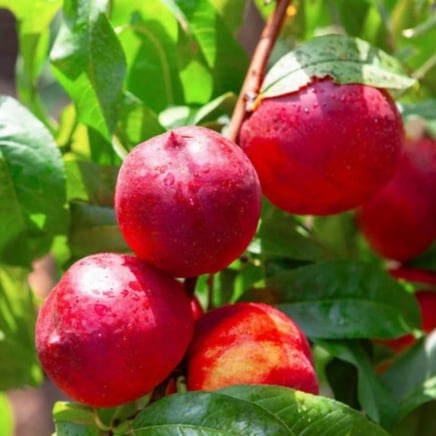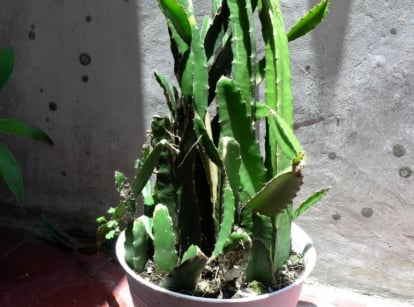When and How to Thin Fruit Trees for Beginners
Thinning is one of the hardest things a fruit tree grower has to do! Though it seems you’re removing the future harvest, you’re helping your tree grow large, juicy fruits instead of many tiny ones. Join backyard grower Jerad Bryant to thin your fruit trees for successful harvests.

Contents
When I first started tending to apple and plum trees, I wondered, “Why is thinning necessary?” Shouldn’t a tree know how to grow without intervention? The truth is that trees grow to survive, while we grow them for their delicious fruit.
Thinning is a way of tricking these species into producing delicious, nutritious, and large annual crops. They’ll want to grow as many seeds as possible to spread their seedlings. Remove some fruit to convince them to push energy into the remaining harvest. This helps create a few dozen perfect fruits rather than a few hundred poor ones.
While this process may seem complicated, it’s easy enough with the right tools and guidelines. Use this guide to help you thin apples, pears, apricots, peaches, persimmons, nectarines, and plums. No matter how big or small your orchard is, thinning will help your trees thrive for many years to come.
Why Thin Fruit Trees?
It’s helpful to understand why to thin trees before learning how and when to do it. With annual thinning, you’ll keep your fruiting species producing well while they stay in tip-top shape. These three main reasons are why growers choose to thin their trees.
Bigger Fruit

The big, juicy apples we see in grocery stores are the result of thinning. Growers thin their trees after the flowers fade, and they only reach that size when the trees are thinning.
With less fruit on their branches, the trees push energy into the remaining ones. This helps the fruits swell to a healthy size, as they can access ample sugar, water, and nutrients.
Without thinning, you’ll create many small fruits with little flavor, texture, or nutritional value. It’s best to thin your trees every year; rather than growing weak crops, you’ll help them form prize-winning harvests.
Better Crop Next Year

Fruiting species are clever—they use their energy in the current season to prepare for the next year. Let’s use apples as an example to illustrate the process.
An apple tree begins developing next year’s fruiting buds while the current season’s apples ripen in spring and summer. If the specimen has too many apples, it will think it doesn’t need to produce a ton next year. You’ll see a poor harvest with little apples.
When you thin, you allow the apple specimen to redistribute some resources into next year’s fruiting buds. You’ll have a better crop this year and the next! This concept applies to other fruiting specimens like pears, nectarines, peaches, and plums.
Healthy Tree

The final reason is to prevent limb breakage and damage during the growing season. Apples, plums, and pears are heavy! As they form, they pull the branches down with their weight. If there are too many of them, they’ll cause the limbs to snap and crack.
Dwarf trees are especially susceptible to breakage, as they produce more fruit than normal on a small structure. Use supports to keep their limbs up while they’re young; mature trees shouldn’t need supports, as their thick limbs hold fruit bunches without issues.
Proper pruning in late winter helps prevent breakage, as you can influence the trees to form strong scaffolding branches. Annual pruning is crucial in maintaining an orchard, just like thinning is.
When to Thin Fruit Trees
There’s a sweet spot when thinning works well. You want to remove the forming fruits before they swell too large. Prompt removal ensures successful harvests this year and the next. Fruiting species flower at different times of the year, so monitor your garden to have an eye on each tree.
Wait for Petal Drop

Flowers are the sex organs of trees. They have pollen, egg cells, and nectar. After insects or the wind dust pollen into the flower’s ovaries, egg cells begin growing into seeds, and the ovaries develop into the fruit.
After successful pollination and fertilization, the petals fall to the ground to make room for the forming fruit.
The petals falling is the first sign it’s time to thin. Look closely at the tree to see if you can see fruit.
Look for Forming Fruit

After the petals fall, swelling fruits take their place. It’s best to remove them before they swell larger than the diameter of a dime. Prompt removal ensures ample fruiting buds form for next year’s harvest.
You may still thin fruits after they’re larger than a dime, but you may have a less successful harvest the next year. Catch them when they’re small, and you’ll help your tree manage its resources.
How to Thin Fruit Trees
A few species, like nuts, cherries, avocados, pomegranates, figs, and citrus, prefer not to be thinned. These specimens moderate their energy levels better than deciduous fruiting species. Proper techniques vary depending on the type of fruit tree you have; consult the guides below for your specific type.
Apple and Pear

Apple and pear species produce fruits on spurs. Spurs are short, stubby, and swollen twigs that develop off the branches. They reliably produce fruits year after year in the same spot. This means you can predict where thinning will occur.
You want to reduce the apples or pears on each spur so one remains. Some spurs produce two or three apples, while others can sprout many more. After reducing each spur to one apple or pear, take stock of how much space there is between each spur.
There should be about six inches in between the ripening fruits. If there are many spurs with less than six inches between them, remove all fruits on a few spurs so there’s proper spacing throughout the canopy. Though this seems harsh, it will help your orchard develop juicy, delicious, and nutritious pears and apples.
Apricot, Peach, and Nectarine

Apricots, peaches, and nectarines most often produce fruits on one-year-old wood rather than spurs. The removal process for these species is a bit different than for apples and pears.
Rather than locating spurs, you’ll remove forming fruits so they have six to eight inches between themselves. Peaches and nectarines tend to drop fruits in June on their own, but they still benefit from manual thinning.
You may leave extra nectarines and peaches on the tree to buffer the June drop. Then, after June, you’ll be able to identify the excess fruits and remove them, leaving six to eight inches between each one. With a few years of practice, you’ll know exactly how many peaches or nectarines to remove before the June drop.
Persimmon

Persimmons form on new and old wood; they appear throughout the canopy on the branches. Persimmon species have weaker wood than the previous types, and thinning is crucial in preventing the limbs from breaking.
Though thinning persimmons is less important for ensuring proper harvests the next year, it’s a good practice for lightening the load on this year’s crop. Start by removing small, spotted, or damaged persimmons first. Then, move through the tree and remove more so the remaining ones have six inches of space between them.
If your persimmon is well structured with strong scaffolding branches, thinning may not be necessary. Young specimens benefit from the process as they have thin, weak limbs that struggle to hold bushels of persimmons.
Plum

Plums are unique in that they produce fruits on spurs and one-year-old wood. This dual strategy allows them to produce bushels of plums each year. Though they’re ample producers, they benefit from thinning shortly after their flowers fall.
Start by removing plums so there’s six inches of space in between each one. Plums, like peaches and nectarines, drop in June on their own. Leave a few extra plums the first year to see how the tree responds. After a few years of thinning, you’ll know exactly how many plums to remove to prepare for the June drop.
If the plums pull down the branches too far, you may have to continue removing them throughout the growing season. Six inches of space should be enough to lighten the load, though some varieties have large, heavy plums. Take a weekly orchard walk to see your plum and how well it’s doing; you’ll catch heavy branches before they break or snap.











